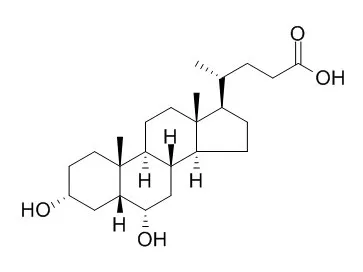| Description: |
Hyodeoxycholic acid is a secondary bile acid formed in the small intestine by the gut flora, and acts as a TGR5 (GPCR19) agonist, with an EC50 of 31.6 µM in CHO cells. Hyodeoxycholic acid has hypolipidemic effect through regulation of FXR activation, it is a candidate for antiatherosclerotic drug, by significantly increasing the expression of genes involved in cholesterol efflux, such as Abca1, Abcg1,and Apoe,in a macrophage cell line. |
| In vitro: |
| J Chromatogr B Analyt Technol Biomed Life Sci. 2006 Sep 14;842(1):22-7. | | Simultaneous determination of geniposide, baicalin, cholic acid and hyodeoxycholic acid in rat serum for the pharmacokinetic investigations by high performance liquid chromatography-tandem mass spectrometry.[Pubmed: 16750434] |
METHODS AND RESULTS:
A simple, rapid, and specific analytical method for simultaneous determination of geniposide, baicalin, cholic acid and Hyodeoxycholic acid in 50 microL samples of rat serum was developed by high performance liquid chromatography-tandem mass spectrometry. The quantification of the target compounds was determined by multiple reaction monitoring (MRM) mode using electrospray ionization (ESI). The correlation coefficients of the calibration curves were better than 0.997. The intra- and inter-day accuracy, precision, and linear range had been investigated in detail.
CONCLUSIONS:
This method was subsequently applied to pharmacokinetic studies of geniposide, baicalin, cholic acid and Hyodeoxycholic acid in rats successfully. |
|
| In vivo: |
| Lipids. 2014 Oct;49(10):963-73. | | Dietary hyodeoxycholic acid exerts hypolipidemic effects by reducing farnesoid X receptor antagonist bile acids in mouse enterohepatic tissues.[Pubmed: 25189147] |
METHODS AND RESULTS:
Mice were fed a control diet or a diet supplemented with Hyodeoxycholic acid, the most abundant bile acid contained in pig bile, for 4 weeks, after which their serum and livers were collected. The contents of total fatty acids of serum and liver cholesteryl esters, and of liver triglycerides, were reduced following the administration of the Hyodeoxycholic acid-supplemented diet, which was mainly due to the reductions in the contents of monounsaturated fatty acids. Free cholesterol contents in the serum and liver were not changed by Hyodeoxycholic acid administration. Hyodeoxycholic acid administration reduced the gene expression levels of sterol regulatory element binding protein 1c, acetyl-CoA carboxylase, fatty acid synthase, and stearoyl-CoA desaturase-1. Hyodeoxycholic acid administration markedly changes the ratio of FXR-antagonist/FXR-agonist bile acids in the enterohepatic tissues of the mice (1.13 and 7.60 in Hyodeoxycholic acid and control diet groups, respectively).
CONCLUSIONS:
Our findings demonstrate that Hyodeoxycholic acid administration exerts the hypolipidemic effect in mice, in which downregulations of de novo lipogenesis and desaturation of saturated fatty acids are suggested to play important roles. In addition, regulation of FXR activation through the selective modification of the enterohepatic bile acid pool may be involved in the hypolipidemic effect of Hyodeoxycholic acid administration. | | FASEB J. 2013 Sep;27(9):3805-17. | | Hyodeoxycholic acid improves HDL function and inhibits atherosclerotic lesion formation in LDLR-knockout mice.[Pubmed: 23752203] | We examined the effects of a natural secondary bile acid, Hyodeoxycholic acid (HDCA), on lipid metabolism and atherosclerosis in LDL receptor-null (LDLRKO) mice.
METHODS AND RESULTS:
Female LDLRKO mice were maintained on a Western diet for 8 wk and then divided into 2 groups that received chow, or chow + 1.25% HDCA, diets for 15 wk. We observed that mice fed the HDCA diet were leaner and exhibited a 37% (P<0.05) decrease in fasting plasma glucose level. HDCA supplementation significantly decreased atherosclerotic lesion size at the aortic root region, the entire aorta, and the innominate artery by 44% (P<0.0001), 48% (P<0.01), and 94% (P<0.01), respectively, as compared with the chow group. Plasma VLDL/IDL/LDL cholesterol levels were significantly decreased, by 61% (P<0.05), in the HDCA group as compared with the chow diet group. HDCA supplementation decreased intestinal cholesterol absorption by 76% (P<0.0001) as compared with the chow group. Furthermore, HDL isolated from the HDCA group exhibited significantly increased ability to mediate cholesterol efflux ex vivo as compared with HDL of the chow diet group. In addition, HDCA significantly increased the expression of genes involved in cholesterol efflux, such as Abca1, Abcg1, and Apoe, in a macrophage cell line.
CONCLUSIONS:
Thus, HDCA is a candidate for antiatherosclerotic drug therapy. |
|






 Cell. 2018 Jan 11;172(1-2):249-261.e12. doi: 10.1016/j.cell.2017.12.019.IF=36.216(2019)
Cell. 2018 Jan 11;172(1-2):249-261.e12. doi: 10.1016/j.cell.2017.12.019.IF=36.216(2019) Cell Metab. 2020 Mar 3;31(3):534-548.e5. doi: 10.1016/j.cmet.2020.01.002.IF=22.415(2019)
Cell Metab. 2020 Mar 3;31(3):534-548.e5. doi: 10.1016/j.cmet.2020.01.002.IF=22.415(2019) Mol Cell. 2017 Nov 16;68(4):673-685.e6. doi: 10.1016/j.molcel.2017.10.022.IF=14.548(2019)
Mol Cell. 2017 Nov 16;68(4):673-685.e6. doi: 10.1016/j.molcel.2017.10.022.IF=14.548(2019)